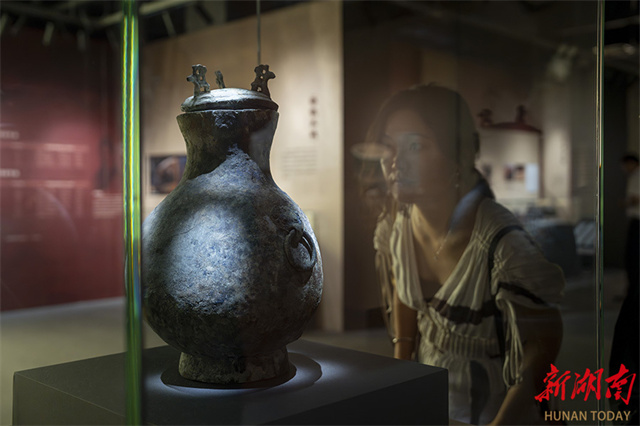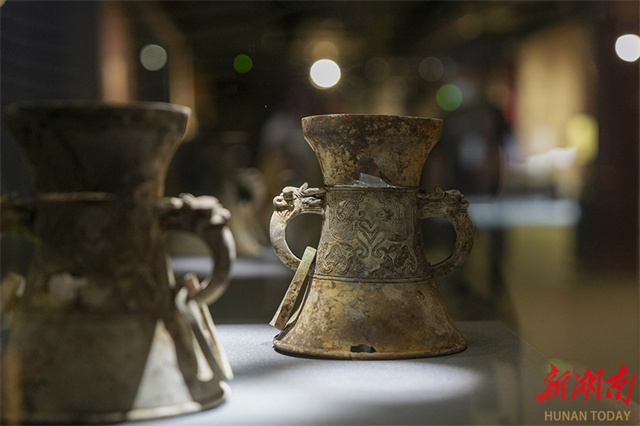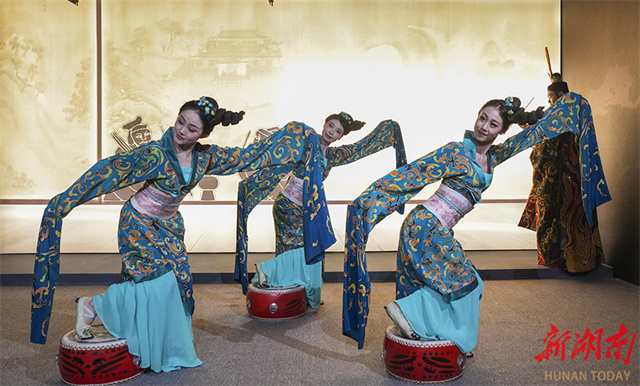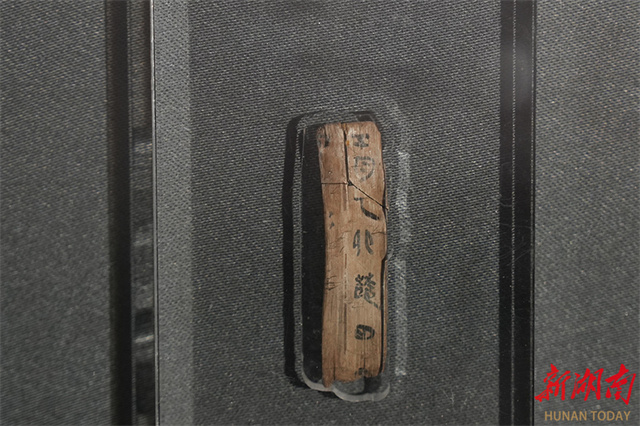
The photo shows visitors admiring the Western Han bamboo slips unearthed from Zoumalou at the Changsha Jiandu Museum. An exhibition titled "Jia Yi, Grand Tutor to the King of Changsha Kingdom, and the City Where He Lived" has opened here recently. The exhibition is divided into three main sections: "Jia Yi Living in Changsha," "Chu-Han Star City," and "Vibrant Xiaoxiang." The exhibition is centered around the archaeological findings from the Chaoyang Lane site and integrates archaeological discoveries in Changsha over the past two decades. It systematically traces the city's cultural heritage from the Chu-Han era's spirit to the vibrant life of Xiaoxiang through more than 300 artifacts. (Photo/Gu Pengbo and Long Wenyang, Hunan Daily)
Tips:
Duration : till May 31, 2026
Venue: Special Exhibition Hall 2, Changsha Jiandu Museum, No. 92, Baisha Road, Tianxin District, Changsha City
Opening hours: 9:00 – 17:00; closed on Tuesday (except public holidays)
Admission: free of charge
Explanatory services for group visits can be booked in advance.
Consulting: 0731-85425680

The photo shows a visitor admiring the Western Han bamboo slips unearthed from Zoumalou at the Changsha Jiandu Museum. An exhibition titled "Jia Yi, Grand Tutor to the King of Changsha Kingdom, and the City Where He Lived" has opened here recently. The exhibition is divided into three main sections: "Jia Yi Living in Changsha," "Chu-Han Star City," and "Vibrant Xiaoxiang." The exhibition is centered around the archaeological findings from the Chaoyang Lane site and integrates archaeological discoveries in Changsha over the past two decades. It systematically traces the city's cultural heritage from the Chu-Han era's spirit to the vibrant life of Xiaoxiang through more than 300 artifacts. (Photo/Gu Pengbo and Long Wenyang, Hunan Daily)

The photo shows a performer giving an performance at the Changsha Jiandu Museum. An exhibition titled "Jia Yi, Grand Tutor
to the King of Changsha Kingdom, and the City Where He Lived" has opened
here recently. The exhibition is divided into three main sections: "Jia
Yi Living in Changsha," "Chu-Han Star City," and "Vibrant Xiaoxiang."
The exhibition is centered around the archaeological findings from the
Chaoyang Lane site and integrates archaeological discoveries in Changsha
over the past two decades. It systematically traces the city's cultural
heritage from the Chu-Han era's spirit to the vibrant life of Xiaoxiang
through more than 300 artifacts. (Photo/Gu Pengbo and Long Wenyang,
Hunan Daily)

The photo shows visitors learning about the Han Dynasty road remains at the Changsha Jiandu Museum. An exhibition titled "Jia Yi, Grand Tutor to the King of Changsha Kingdom, and the City Where He Lived" has opened here recently. The exhibition is divided into three main sections: "Jia Yi Living in Changsha," "Chu-Han Star City," and "Vibrant Xiaoxiang." The exhibition is centered around the archaeological findings from the Chaoyang Lane site and integrates archaeological discoveries in Changsha over the past two decades. It systematically traces the city's cultural heritage from the Chu-Han era's spirit to the vibrant life of Xiaoxiang through more than 300 artifacts. (Photo/Gu Pengbo and Long Wenyang, Hunan Daily)

The photo shows a performer interacting with visitors at the Changsha Jiandu Museum. An exhibition titled "Jia Yi, Grand Tutor to the King of Changsha Kingdom, and the City Where He Lived" has opened here recently. The exhibition is divided into three main sections: "Jia Yi Living in Changsha," "Chu-Han Star City," and "Vibrant Xiaoxiang." The exhibition is centered around the archaeological findings from the Chaoyang Lane site and integrates archaeological discoveries in Changsha over the past two decades. It systematically traces the city's cultural heritage from the Chu-Han era's spirit to the vibrant life of Xiaoxiang through more than 300 artifacts. (Photo/Gu Pengbo and Long Wenyang, Hunan Daily)

The photo shows an exhibit on display at the Changsha Jiandu Museum. An exhibition titled "Jia Yi, Grand Tutor to the King of Changsha Kingdom, and the City Where He Lived" has opened here recently. The exhibition is divided into three main sections: "Jia Yi Living in Changsha," "Chu-Han Star City," and "Vibrant Xiaoxiang." The exhibition is centered around the archaeological findings from the Chaoyang Lane site and integrates archaeological discoveries in Changsha over the past two decades. It systematically traces the city's cultural heritage from the Chu-Han era's spirit to the vibrant life of Xiaoxiang through more than 300 artifacts. (Photo/Gu Pengbo and Long Wenyang, Hunan Daily)

The photo shows visitors watching an immersive performance at the Changsha Jiandu Museum. An exhibition titled "Jia Yi, Grand Tutor to the King of Changsha Kingdom, and the City Where He Lived" has opened here recently. The exhibition is divided into three main sections: "Jia Yi Living in Changsha," "Chu-Han Star City," and "Vibrant Xiaoxiang." The exhibition is centered around the archaeological findings from the Chaoyang Lane site and integrates archaeological discoveries in Changsha over the past two decades. It systematically traces the city's cultural heritage from the Chu-Han era's spirit to the vibrant life of Xiaoxiang through more than 300 artifacts. (Photo/Gu Pengbo and Long Wenyang, Hunan Daily)

The photo shows performers staging a performance at the Changsha Jiandu Museum. An exhibition titled "Jia Yi, Grand Tutor to the King of Changsha Kingdom, and the City Where He Lived" has opened here recently. The exhibition is divided into three main sections: "Jia Yi Living in Changsha," "Chu-Han Star City," and "Vibrant Xiaoxiang." The exhibition is centered around the archaeological findings from the Chaoyang Lane site and integrates archaeological discoveries in Changsha over the past two decades. It systematically traces the city's cultural heritage from the Chu-Han era's spirit to the vibrant life of Xiaoxiang through more than 300 artifacts. (Photo/Gu Pengbo and Long Wenyang, Hunan Daily)

The photo shows visitors viewing exhibits on display at the Changsha Jiandu Museum. An exhibition titled "Jia Yi, Grand Tutor to the King of Changsha Kingdom, and the City Where He Lived" has opened here recently. The exhibition is divided into three main sections: "Jia Yi Living in Changsha," "Chu-Han Star City," and "Vibrant Xiaoxiang." The exhibition is centered around the archaeological findings from the Chaoyang Lane site and integrates archaeological discoveries in Changsha over the past two decades. It systematically traces the city's cultural heritage from the Chu-Han era's spirit to the vibrant life of Xiaoxiang through more than 300 artifacts. (Photo/Gu Pengbo and Long Wenyang, Hunan Daily)

The photo shows an exhibit on display at the Changsha Jiandu Museum. An exhibition titled "Jia Yi, Grand Tutor to the King of Changsha Kingdom, and the City Where He Lived" has opened here recently. The exhibition is divided into three main sections: "Jia Yi Living in Changsha," "Chu-Han Star City," and "Vibrant Xiaoxiang." The exhibition is centered around the archaeological findings from the Chaoyang Lane site and integrates archaeological discoveries in Changsha over the past two decades. It systematically traces the city's cultural heritage from the Chu-Han era's spirit to the vibrant life of Xiaoxiang through more than 300 artifacts. (Photo/Gu Pengbo and Long Wenyang, Hunan Daily)
This article is from Hunan Provincial Government. www.enghunan.gov.cn.
Translator: Kuang Zhenzhen
Chinese source: hunantoday








